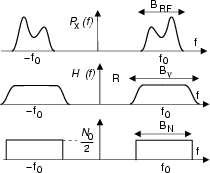




Avanti: Demodulazione di un processo di rumore
Su: Il rumore nei segnali modulati
Indietro: Il rumore nei segnali modulati
Indice
Indice analitico
Per descrivere la qualità del segnale modulato ricevuto, si ricorre al rapporto
indicato come SNR LOCALE, a sottolineare la sua dipendenza dalla frequenza.
Per ciò che riguarda
 x
x f
f , questo è ottenibile
come illustrato al capitolo precedente, una volta noto il segnale modulante
e la tecnica di modulazione, mentre
, questo è ottenibile
come illustrato al capitolo precedente, una volta noto il segnale modulante
e la tecnica di modulazione, mentre


 f
f risulta pari a
risulta pari a
D'altra parte, ha senso valutare l'SNR complessivo, ovvero il
rapporto tra le potenze di segnale e di rumore totali. Per ciò che riguarda
il segnale, è ben noto che
 y =
y = 
 y
y f
f df;
in modo analogo, si ottiene
df;
in modo analogo, si ottiene

 =
= 

 HR
HR f
f
 df,
valutandone cioè la potenza che attraversa il filtro di ricezione
HR
df,
valutandone cioè la potenza che attraversa il filtro di ricezione
HR f
f .
Data l'impossibilità pratica di realizzare un filtro ideale (rettangolare),
HR
.
Data l'impossibilità pratica di realizzare un filtro ideale (rettangolare),
HR f
f è caratterizzato da una banda (a frequenze positive)
B
è caratterizzato da una banda (a frequenze positive)
B , piú estesa di BRF (che è la banda di segnale).
, piú estesa di BRF (che è la banda di segnale).
La potenza totale del rumore uscente da
HR f
f risulta
pertanto pari a
risulta
pertanto pari a
  |
= |
 . .   HR HR f f  df = df =  . 2 . . 2 .   HR HR f f  df = df = |
|
| |
= |
N0BN HR HR f0 f0  |
|
Il termine BN rappresenta la cosiddetta banda di rumore definita
come
BN =

ossia come la banda di un filtro ideale (rettangolare) che lascia passare la
stessa quantità di rumore.





Avanti: Demodulazione di un processo di rumore
Su: Il rumore nei segnali modulati
Indietro: Il rumore nei segnali modulati
Indice
Indice analitico
alef@infocom.uniroma1.it
2001-06-01
![]() y =
y = ![]()
![]() y
y![]() f
f![]() df;
in modo analogo, si ottiene
df;
in modo analogo, si ottiene
![]()
![]() =
= ![]()
![]()
![]() HR
HR![]() f
f![]()
![]() df,
valutandone cioè la potenza che attraversa il filtro di ricezione
HR
df,
valutandone cioè la potenza che attraversa il filtro di ricezione
HR![]() f
f![]() .
Data l'impossibilità pratica di realizzare un filtro ideale (rettangolare),
HR
.
Data l'impossibilità pratica di realizzare un filtro ideale (rettangolare),
HR![]() f
f![]() è caratterizzato da una banda (a frequenze positive)
B
è caratterizzato da una banda (a frequenze positive)
B![]() , piú estesa di BRF (che è la banda di segnale).
, piú estesa di BRF (che è la banda di segnale).

